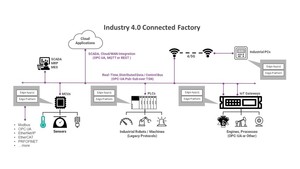

|
Edward Lowton
Editor |


|
| Home> | Plant, Process & Control | >Industry 4.0 | >Edge computing set to revolutionise manufacturing |
Edge computing set to revolutionise manufacturing
05 May 2023
The need for more flexible and open industrial plant and automation systems, combined with the emergence of the IoT, Industry 4.0, and advances in AI/ML, is driving the adoption of a new generation of edge computing solutions, says Andrew Foster

WITH THE emergence of the IoT, Industry 4.0, advances in AI/ML and new standards focused on plant and factory automation, edge computing is playing a pivotal role in a new generation of smart factories by enabling the integration of both operational technology (OT) and information technology (IT)/cloud processes across an organisation.
Software defined automation
One of the biggest changes that industrial plant and automation systems are undergoing is the move away from the use of hardware-centric (e.g. PLC) technologies with relatively limited software capabilities. Traditional automation solutions tend to have a single dedicated function and their data siloed from other parts of the system.
These solutions are difficult to extend to support new use cases/functions and very expensive to replace. Manufacturing companies are pushing for greater flexibility that can be gained from more open and software configurable solutions to better meet both their current and future requirements as they digitise their factories.
Edge computing is enabling a new generation of automation systems that are starting to replace traditional hardware centric edge systems with new software-defined edge solutions. These new systems can utilise commodity hardware (IPC and server technologies) and commercial operating systems (e.g. Linux) technology to replace traditional PLC and PACs.
The new generation of edge computing solutions are bringing many of the benefits of cloud computing such as containerisation and virtualisation. These solutions also deliver modern approaches to application orchestration and updating to the OT world.
In particular, the use of virtualisation means that automation systems can now support multiple independent parallel workloads on the same hardware. For example, one VM could be used to host a PLC workload running a closed loop control application. A second VM could be running a predicative analytics application, while a third VM is used to host a local data historian. Other VMs can be added to support additional workloads as the system evolves.
Edge computing is enabling a new generation of smart industrial applications that are able to leverage the latest advances in artificial intelligence (AI) and machine learning (ML). The use of advanced analytics at the edge to support new data driven use cases - such as performance optimisation of plant equipment or video inferencing for default detection on a production line--can create real operational benefits and reduce costs.
Model based AI and ML are becoming mainstream edge computing technologies that are being used effectively beside more conventional control systems. Although challenges still remain with respect to how to deploy, retrain and update models running at the edge, which is currently too difficult and expensive.
To support this trend, traditional hardware-based PLCs are increasingly being replaced by software alternatives. The market has seen a range of both commercial and open-source soft PLC products based on either IEC 61131 or IEC 61499 emerge in the last few years.
Abstracting OT systems and standardising communications
Edge computing enables the fusion of data from multiple sources, both legacy and new, from which new insights and business value can be derived. However, this means that new data-driven industrial edge applications may need to communicate with a variety of equipment using a plethora of communication protocols (e.g. Modbus, BACnet, OPC UA, EtherCAT, EtherNet/IP etc.,), and to acquire and normalise the data from a disparate set of endpoints.
A traditional automation application would access this data directly from a dedicated PLC. This would inevitably lead to non-interoperable siloed system. A new generation of OT protocol agnostic open edge platforms are critical to abstracting this complexity. They can provide a portable and interoperable way for applications to evolve as new use cases are deployed and systems updated. They also help protect existing investments by enabling the integration of data from both brownfield equipment and new greenfield systems.
These new edge platforms typically provide a normalised OPC UA server layer into which data from all other OT endpoints (e.g. EtherCAT) is mapped. For industrial plant and automations system OPC UA is emerging as the de-facto communication standard through which other edge applications or higher level SCADA or ERP systems interface. Although, other communication protocols that have evolved from the IT world such as MQTT are also being heavily used for asynchronous edge communications.
Both commercial and open-source edge software platform implementations have emerged over the last few years. These have reached a level of maturity that now offers the industrial automation providers with a range of viable options on which to base their solutions.
A key open-source initiative with broad cross-industry support is the Linux Foundation’s LF Edge. The objective of LF Edge is to establish an open, interoperable framework for edge computing. EdgeX Foundry is one of the largest projects under the LF Edge umbrella. It provides a flexible and scalable open software platform that facilitates interoperability between OT equipment and applications at the edge. EdgeX Foundry and its commercial derivates, such as IOTech’s Edge Xpert, are seeing increasing adoption within industrial plant and factory systems.
Hybrid edge-cloud automation architectures
The transformation to smarter factories is accelerating the need for fully distributed architectures driven by edge computing. Cloud computing alone is unable to handle the vast amounts of data generated by the OT systems and cannot meet the need for local insights from the latency-sensitive applications on which they depend.
What is also clear is that most automation systems will not rely 100% on edge computing solutions. In fact, fully autonomous edge applications are quite rare. Most systems require a hybrid solution consisting of both edge and cloud components. To be successful, users require the ability to utilise cloud resources for heavy-duty applications, while using edge computing for lighter-weight processing and local, real-time insights.
As OT and IT systems converge, achieving seamless interoperability between edge and cloud environments is critical. This is an area where OT and cloud agnostic open edge platforms are again playing an essential role as bridge between the two worlds.
Edge management
The business value that new edge computing solutions can bring to the industrial plant and automation markets is becoming widely accepted and organizations are starting to deploy at scale. However, challenges still remain due to heterogeneous nature of the industrial edge. These include:
- supporting the wide range of devices that the applications must run on such as PLCs, MCUs, IPCs, IoT gateways, servers;
- configuring the applications to communicate with the many different OT endpoints;
- monitoring and updating a deployed system during its lifetime.
Trying to do this at scale with a man-in-the-loop is not practical. Cloud native application orchestration technologies such as Kubernetes are being used with some success within industrial automation solutions. However, Kubernetes is only suitable for containerised workloads (what about deploying binaries?) and, due to its memory requirements, is not suitable for all edge devices (e.g. PLC or MCU).
Work is ongoing by the Kubernetes community, however, to reduce its memory footprint. The challenge is also broader than just the edge applications. An end-to-end edge management solution must also address the management of the nodes the applications will run on and the OT devices/sensors with which the applications will communicate.
To accelerate the adoption of new edge computing technologies, the plant and automation market requires a new generation of management solutions focused on the unique needs of the industrial edge.
Andrew Foster is product director at IOTech Systems
For more information:
Tel: 019181 42220
- Women still being overlooked on PPE, research shows
- Tweeting out for Industry
- A new way to produce jigs and fixtures
- Small engineering component packaging
- Government restructure tackles 'hideous waste of talent'
- Advanced materials research and innovation hub opens
- Liebherr ship-to-shore cranes assembled efficiently at Valencia port
- UK engineer firms leading the way in apprentice recruitment
- Spring into Jefferson Tools’ seasonal Tool Up offers
- DALI over wireless & IP-based networks
- Introducing Industry 4.0 to SMEs
- Enhance maintenance practices
- Digital transformation: Customer insight matters
- IoT digital experiments as a service
- Smarter maintenance: Paper available
- Condition monitoring & Industry 4.0
- Smart data collection
- Mechanised welding, cutting and Industry 4.0
- Tomorrow’s tech is here today
- The business value of Industry 4.0




















